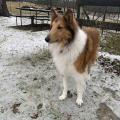Concerns to consider when building rabbit facilities
The following information related to the design and construction of rabbitry facilities. This information is not complete unless a few observations and recommendations are proposed. These observations are as follows:
- Do not stack breeder cages more than two tiers high--a two tier height is ideal. More tiers produce management problems, one tier is less economical.
- Select or install cages using leg supports rather than cages suspended from the ceiling. The stability of the cages is improved and extra reinforcement of the building's ceiling is not necessary.
- Provide a good drainage system under the cages to remove undesirable liquid wastes--Waterer leakage as well as urine.
- Plan and install a good solid waste removal system. Leaving solid wastes in the house eventually leads to problems related to pests, odors, disease problems or poor management. Too much waste is generated in a small amount of space.
- Build the house with adequate space for the cages. A 32-foot wide house permits the installation of three rows of cages while a 40-foot wide house can accept up to four rows of cages. One thousand rabbits require a house at least 32' x 310' or 40' x 250'.
- Provide adequate mechanical ventilation (fans) capacity. Do not rely on natural air movement to provide for good air quality and cooling for the rabbitry. Contact agricultural engineers or your County Agent for recommendations.
- Insulate your rabbitry building properly. Plan your house with a minimum of 1" of rigid polyurethane or 3" of fiberglass insulation under the roof and in the side walls. A well insulated house will be more beneficial to prevent heat buildup in the summer than maintaining interior house temperatures in winter. The house will also have lower energy costs to operate. Provide good vapor barriers.
- A house without roof pole supports (pole barn) is recommended. Examples of clear-span types of houses are available on request.
News
STARKVILLE, Miss.


